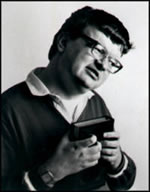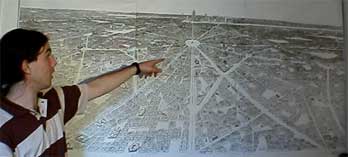Prodigious aspects of James Joyce Mind
When we agreed on how to treat the situation of a supposed mental health status of Joyce, Dr. Darold pointed out perhaps the most important argument adjacent to all that , and I quote it here with my answer about prodigious aspects of the mind in general and those of Joyce.
The advantages of the assumed point of view are:
First: We do not diagnose Joyce! We will stick to the effects he left from his prodigious brain... We will compare these effects with those of the group he seems to be part of and he will enter there naturally, by his own merits. and only by merits... there is no point in making an inventory of quirks, eccentricities, odd behaviours... any human being has them...
Second: It is obvious that culture has been distorting the aspergers (and autism) and for reasons I prefer not point out, some people are using these distortions improperly.
Third there is too much emphasis on computer like, specially mathematics enhancements, or memory, what, if you take for what it is without prejudice, doesn't mean much, because the computer power available today is limitless and it is just a matter of setting up one of those machines and you will have any amount of fantastic calculations and memory you deem to go through and it is within the brain power of the average person to do that
The exceptional
part of the brain is not related to mechanical or mathematical things
or prodigious memory... it belongs to the spirit...that has to be seated in
the brain mostly (it seems to me that the body is kind of interface)
The discussion left to later starts here and it is the central points of this
whole job.
Joyce invented a religion and he couldn't swallow the many "falls"
he went through and he vindicated himself autobiographically... and it is all
related to the meaning of life and we will take a look on that now
Last but not least and I quote Dr Darold : "But I wonder if the brain can transcend itself to figure itself out totally. I don't think so. There may be that inherent barrier……and that might be a good thing, leaving room for some mystery, secrecy individuality and 'differently abled' capacity in that last frontier of our being".
Biblically this should be the response to the original sin, which made us fall, or rephrasing it religiously: can we stand up? and go back to paradise? That was what Joyce was up to.
We have to reconcile religion with
thinking. The only and basic questions is not if God Exists, because it is obvious
that His creation or not, the world exists and we also do exist. And it is absolutely
stupid to discuss such a power, whatever it may be, if it exists, considering
that the world does exist. What does not exist is brain
power to grasp it...and it is what Dr Darold points out. The problem
is to come to grips to a perception of a Just God, that is the only way to be
good.
This is exactly Joyce's Quest: Reconciliation of what he perceived as man, as
an individual, as an Irishman, as anything he was. He didn't like and didn't
agree with what he perceived and decided to create another version than those
existing and which were instilled in him and I do not mean teached, because
he was very much autodidact and there is that phenomena of exceptional brains
such as the ones we will be using to compare to Joyce: it seems that there are
things that their owners know that weren't taught to them... it
came with them...
A few premises
This job will privilege rational thinking but it will not despise other forms of thinking and will try to co-opt them with rationality. And by no means it is scientifically thinking....I do not intend to elaborate a thesis on that, but since at the moment what mankind is living seems to tell him that science has or someday will have all the answers, I will tell a tale that very properly equates what I mean:
These premises should be considered together with "The exceptional art of the brain", the "Last but not least " from the list above and the intention to privilege rational thinking versus neuroscience, specially brain scans and some considerations at the article by Raymond Tallis on the Guardian "Think brain scans can reveal our innermost thoughts? Think again" and " The Limits of Neuro-Talk" by Matthew B. Crawford and adjacent articles, which I organized for those who are interested and for those who are not interested or lack the trainning to follow the imbeded papers, I have elaborated a visual approach and sintetized version of it all in my summary "The new Phrenology" which is enough to substantiate the following:
The cat of Thomas
Edison
Thomas Alva Edison did not only invent the light bulb and was a genius.
To appreciate him it would be necessary to go beyond the more than 1000 (thousand)
patents he had, including the light bulb, the phonograph and the cinema.
He invented the modern research laboratory, which is the way that transforms
scientific knowledge into technological products incorporated to the daily life
of humanity. In other words, he invented the "process of inventing"
...
He worked first at Menlo Park laboratory, moving to West Orange N.Jersey, where
he built the "Edison Laboratory", which is a US National Monument
and a real factory of how to invent invention and it is worth a visit.
In this lab, lived for a long time, a cat, from its birth until its death.
This cat, a beloved pet of Edison, was free to move anywhere and this allowed
this cat to learn where it was everything inside the lab: from the benches where
lamps were developed, through the prototype construction lines and to the Edison
room, where it is thought that he should be driving the complex.
And Edson was who the cat knew better, as he was his pet.
Well, this cat knew where everything was inside and that originated what we
know, however, had no idea what was going on in there!
There is a heck of a lot of translators of Joyce and people who explain his
ideas that are like this cat…
And to that it should be added The Owl of Minerva or The Owl of Athena
When thought under Georg Wilhelm Friedrich Hegel when he noted, "the owl of Minerva spreads its wings only with the falling of the dusk"—meaning that philosophy comes to understand a historical condition just as it passes away. Philosophy cannot be prescriptive because it understands only in hindsight.
“ One more word about giving instruction as to what the world ought to be. Philosophy in any case always comes on the scene too late to give it... When philosophy paints its gloomy picture then a form of life has grown old. It cannot be rejuvenated by the gloomy picture, but only understood. Only when the dusk starts to fall does the owl of Minerva spread its wings and fly. ”
—G.W.F. Hegel, Philosophy of Right (1820), "Preface"
Although not a philosopher, Joyce very much fits in this, although it is debatable if he understood it or if he was only encountering a fitting to his 'differently-abled' mind and his astounding ability in a selected area.
Typical Astounding abilities (Before we go into Joyce's astounding abilities)
Extracted from Alex Santoso Neatorama
1. Kim Peek, the Real Rain Man

Even though you've never heard of
Kim Peek, chances are you've heard the movie Rain Man. Kim was the inspiration
for the character played by Dustin Hoffman in the movie.
Kim Peek was born with severe brain damage. His childhood doctor told Kim's
father to put him in an institution and forget about the boy. Kim's severe developmental
disabilities, according to the doctor, would not let him walk let alone learn.
Kim's father disregarded the doctor's advice.
Till this day, Kim struggles with ordinary motor skills and has difficulty walking.
He is severely disabled, cannot button his shirt and tests well below average
on a general IQ test.
But what Kim can do is astounding: he has read some 12,000 books and remembers
everything about them. "Kimputer," as he is lovingly known to many,
reads two pages at once - his left eye reads the left page, and his right eye
reads the right page. It takes him about 3 seconds to read through two pages
- and he remember everything on 'em. Kim can recall facts and trivia from 15
subject areas from history to geography to sports. Tell him a date, and Kim
can tell you what day of the week it is. He also remembers every music he has
ever heard.
Since the movie Rain Man came out, Kim and his father have been traveling across
the country for appearances. The interaction turns out to be beneficial for
him, as he becomes less shy and more confident.
Further reading about Kim Peek:
Kim
Peek [wikipedia]
Kim
Peek - The Real Rain Man (Please search Kim Peek)
On YouTube: Kim Peek
- The Real Rain Man (a series of 5 clips)
(Photo: Kim Peek courtesy of Darold A. Treffert / Wisconsin Medical Society)
2. Leslie Lemke

Leslie Lemke didn't have a great start in life. He was born with severe birth defects that required doctors to remove his eyes. His own mother gave him up for adoption, and a nurse named May Lemke (who at the time was 52 and was raising 5 children of her own) adopted him when he was six months old.
As a young child, Leslie had to be force-fed to teach him how to swallow. He could not stand until he was 12. At 15, Leslie finally learned how to walk (May had to strap his fragile body to hers to teach him, step by step, how to walk).
At 16 years of age, Leslie Lemke bloomed. In the middle of one night, May woke up to find Leslie playing Tchaikovsky's Piano Concerto No. 1. Leslie, who has no classical music training, was playing the piece flawlessly after hearing it just once earlier on the television.
From then on, Leslie began playing all styles of music from ragtime to classical. Like the Tchaikovsky piece, he only has to hear the music once in order to play it again perfectly. He became famous after being portrayed in national television shows. Before his health started to deteriorate, Leslie gave many concerts around the world.
More info about Leslie Lemke:
Leslie
Lemke - Wikipedia
Leslie
Lemke - An Inspirational Performance(Please search Leslie Lemke)
Leslie
Lemke popular videos[YouTube]
4. Gottfried Mind: Cat's Raphael

Gottfried Mind was one of the earliest savants in history. In 1776, the eight-year-old Gottfried was placed in an art academy, where his teachers noted that he was "very weak, incapable of hard work, full of talent for drawing, a strange creature, full of artist-caprices, along with a certain roguishness."
One day, Gottfried's mentor, a painter named Sigmund Hendenberger, was drawing a cat when Gottfried exclaimed "That is no cat!" The teacher asked whether he could do better and sent the child to a corner to draw. The cat that Gottfried drew was so lifelike that since then he became known as the Cat's Raphael:
In the course of his narrow, indoors life, he had worked himself into an almost paternal relation with domestic animals, especially with cats. While he sat painting, a cat might generally be seen sitting on his back or on his shoulder; many times he kept, for hours, the most awkward postures, that he might not disturb it. Frequently there was a second cat sitting by him on the table, watching how the work went on; sometimes a kitten or two lay in his lap under the table. Frogs (in bottle) floated beside his easel; and with all these creatures he kept up a most playful, loving style of conversation; though, often enough, any human beings about him, or such even as came to see him, were growled or grunted at in no social fashion. (Gottfried MInd)
5. Gilles Tréhin



Gilles Trehin is a 34 year old Frenchman who has created a city in his mind called Urville. In more that 200 drawings, he has crafted a city with an elaborate history reaching back to before the Middle Ages, complete with an entire culture that includes religious, political, and economic records. The city’s life is mapped out with information about its universities, industries, and cultural events. Gilles, who has been diagnosed as autistic but probably has an autistic spectrum condition called Asperger’s Syndrome, is an angelic looking man who hopes to make a living as an artist. He also has perfect pitch and an interest in prime numbers. His first word, at three years old, was “airplane.”
Earlier stories about Gilles have focused on his autism, making him sound like an inordinately gifted chimp. After watching this video of him, I see that he is an intelligent but somewhat otherworldly young man with a truly beautiful spirit. His drawings are awe-inspiring, and his prodigious intelligence is very moving to behold — for me, anyway. Rather than being a poster-boy for the disabled, Gilles Trehin is a multi-gifted genius who should be celebrated as such. You can see some of drawings here at the Kircher Society, (whose dedication to “the wondrous” makes it a delightful website to visit.)
Gilles Trehin’s book, Urville, published by Jessica Kingsley, is available from Amazon.com and directly from the publisher.

Jedediah Buxton, born in Derbyshire, England, in 1707, couldn't write. By all accounts, he has no knowledge of science or history or anything else for that matter except for numbers. Jedediah, as it turned out, was one of the world's earliest mental calculators and savants.
Everything was numbers to Jedediah - in fact, he associated everything he saw or experienced with numbers. He measured the area of the village he was born in simply by walking around it. When he saw a dance, his whole attention was to count the number of steps of the dancers. At a play, Jedediah was consumed with counting the number of words uttered by the actors.
The mental feat of Jedediah Buxton was tested by the Royal Society in 1754 - his mathematical brain was able to calculate numbers up to 39 figures.
7. Orlando Serrell

Orlando Serrell wasn't born autistic - indeed, his savant skills only came about after a brain injury. In 1979, then ten-year-old Orlando was playing baseball when the ball struck him hard on the left side of his head. He fell to the ground but eventually got up to continue playing.
For a while, Orlando had headaches. When they went away, he realized he had new abilities: he could perform complex calendar calculations and remember the weather every day from the day of the accident.
From Orlando's official website:
What makes Orlando Serrell so unique is that he may indeed hold the key that unlocks the genius in us all. Orlando Serrell did not possess any special skills until he was struck in the head by a baseball when he was 10. And his extraordinary gifts seem to be his only side effect. Could this mean once a key hemisphere in the brain is stimulated, we can all attain the level of genius Orlando posses and beyond? Only time and research will tell. Until then we will do well to keep our eyes on Orlando and learn what we can from his experience.
8.Stephen Wiltshire, the Human Camera


As a young child, Stephen Wiltshire was a mute - he was diagnosed as autistic and was sent to a school for special needs children. There, he discovered a passion for drawing - first of animals, then London buses, then buildings and the city's landmarks. Throughout his childhood, Stephen communicated through his drawings. Slowly, aided by his teachers, he learned to speak by the age of nine (his first word was "paper.")
Stephen has a particularly striking talent: he can draw an accurate and detailed landscape of a city after seeing it just once! He drew a 10 meter (~33 ft) long panorama of Tokyo following a short helicopter ride.
9. Ellen Boudreaux

Like Leslie Lemke, Ellen Boudreaux is a blind autistic savant with exceptional
musical abilities. She can play music perfectly after hearing it just once,
and has a such a huge repertoire of songs in her head that a newspaper reporter
once tried to "stump Ellen" by requesting that she played some obscure
songs - and failed. Ellen knew them all.
Ellen has two other savant skills that are unusual. First, despite her blindness, she is able to walk around without ever running into things. As she walks, Ellen makes little chirping sounds that seems to act like a human sonar (See also our post on Ben Underwood, a blind teen who uses echolocation to "see").
Second, Ellen has an extremely precise digital clock ticking in her mind. To help overcome her fear of the telephone, Ellen's mom coaxed her to listen to the automatic time recording (the "time lady") when she was 8. From then on, Ellen knows the exact hour and minute, any time of the day without ever having seen a clock nor have the concept of the passing of time explained to her.
10. Daniel Tammet: Brainman

At first glance, you won't be able to tell that Daniel Tammet is anything but normal. Daniel, 29, is a highly functioning autistic savant with exceptional mathematical and language abilities.
Daniel first became famous when he recited from memory Pi to 22,514 decimal places (on 3/14, the International Pi Day, of course) to raise funds for the National Society for Epilepsy.
Numbers, according to Daniel, are special to him. He has a rare form of synesthesia and sees each integers up to 10,000 as having their own unique shapes, color, texture and feel. He can "see" the result of a math calculation, and he can "sense" whether a number is prime. Daniel has since drawn what pi looks like: a rolling landscape full of different shapes and colors.
Daniel speaks 11 languages, one of which is Icelandic. In 2007, Channel Five documentary challenged him to learn the language in a week. Seven days later, Daniel was successfully interviewed on Icelandic television (in Icelandic, of course!).
When he was four years old, Daniel had bouts of epilepsy that, along with his autism, seemed to have brought about his savant abilities. Though he appears normal, Daniel contends that he actually had to will himself to learn how to talk to and behave around people:
As he describes in his newly published memoir, “Born on a Blue Day: Inside the Extraordinary Mind of an Autistic Savant” (Free Press), he has willed himself to learn what to do. Offer a visitor a drink; look her in the eye; don’t stand in someone else’s space. These are all conscious decisions.
Recently, some friends warned him that in his eagerness to make eye contact, he tended to stare too intently. “It’s like being on a tightrope,” he said. “If you try too hard, you’ll come off. But you have to try.” (Source)
There is a big difference between Daniel Tammet and all the other prodigious savants in the world: Daniel can tell you how he does it and that makes him invaluable to scientists trying to understand the savant syndrome:
Professor Allan Snyder, from the Centre for the Mind at the Australian National University in Canberra, explains why Tammet is of particular, and international, scientific interest. "Savants can't usually tell us how they do what they do," says Snyder. "It just comes to them. Daniel can. He describes what he sees in his head. That's why he's exciting. He could be the Rosetta Stone." (Source)
More info about Daniel Tammet:
Official website and blog
60 Minutes Interview
Born on a Blue Day, Daniel's autobiography (Daniel was born on a Wednesday,
a day he perceived as blue).
Daniel Tammet - The Boy with the Incredible Brain (5 clips)